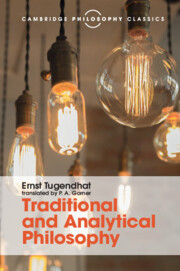Book contents
- Frontmatter
- Dedication
- Contents
- Preface
- Preface
- Translator's preface
- Part I Introduction: confrontation of analytical philosophy with traditional conceptions of philosophy
- Part II A first step: analysis of the predicative sentence
- 8 Preliminary reflections on method and preview of the course of the investigation
- 9 Husserl's theory of meaning
- 10 Collapse of the traditional theory of meaning
- 11 Predicates: the first step in the development of an analytical conception of the meaning of sentences. The dispute between nominalists and conceptualists
- 12 The basic principle of analytical philosophy. The dispute continued. Predicates and quasi-predicates
- 13 The meaning of an expression and the circumstances of its use. Dispute with a behaviouristic conception
- 14 The employment-rule of an assertoric sentence. Argument with Grice and Searle
- 15 Positive account of the employment-rule of assertoric sentences in terms of the truth-relation
- 16 Supplements
- 17 ‘And’ and ‘or’
- 18 General sentences. Resumption of the problem of predicates
- 19 The mode of employment of predicates. Transition to singular terms
- 20 What is it for a sign to stand for an object? The traditional account
- 21 The function of singular terms
- 22 Russell and Strawson
- 23 What is ‘identification’?
- 24 Specification and identification. Specification and truth
- 25 Spatio-temporal identification and the constitution of the object-relation
- 26 Supplements
- 27 Results
- 28 The next steps
- Bibliography
- Index of names
- Index of subjects
19 - The mode of employment of predicates. Transition to singular terms
from Part II - A first step: analysis of the predicative sentence
Published online by Cambridge University Press: 05 August 2016
- Frontmatter
- Dedication
- Contents
- Preface
- Preface
- Translator's preface
- Part I Introduction: confrontation of analytical philosophy with traditional conceptions of philosophy
- Part II A first step: analysis of the predicative sentence
- 8 Preliminary reflections on method and preview of the course of the investigation
- 9 Husserl's theory of meaning
- 10 Collapse of the traditional theory of meaning
- 11 Predicates: the first step in the development of an analytical conception of the meaning of sentences. The dispute between nominalists and conceptualists
- 12 The basic principle of analytical philosophy. The dispute continued. Predicates and quasi-predicates
- 13 The meaning of an expression and the circumstances of its use. Dispute with a behaviouristic conception
- 14 The employment-rule of an assertoric sentence. Argument with Grice and Searle
- 15 Positive account of the employment-rule of assertoric sentences in terms of the truth-relation
- 16 Supplements
- 17 ‘And’ and ‘or’
- 18 General sentences. Resumption of the problem of predicates
- 19 The mode of employment of predicates. Transition to singular terms
- 20 What is it for a sign to stand for an object? The traditional account
- 21 The function of singular terms
- 22 Russell and Strawson
- 23 What is ‘identification’?
- 24 Specification and identification. Specification and truth
- 25 Spatio-temporal identification and the constitution of the object-relation
- 26 Supplements
- 27 Results
- 28 The next steps
- Bibliography
- Index of names
- Index of subjects
Summary
‘The assertion that a is F is true if and only if the predicate “F” applies to the object for which the singular term “a” stands.’ With this truth-definition a start is made in the analysis of the meaning of predicative sentences. But it is only a start. The transition from this first level of semantic analysis to the crucial second level, which consists in the explanation of use, will prove much more difficult in the case of predicative sentences than in the case of truth-functional sentences. You will therefore not be prepared to undertake the lengthy analyses that are now required unless I am able to convince you that this first level of explanation of meaning does not suffice for the fundamental analysis of the meaning of predicative sentences we are here aiming at.
In the last lecture I explained the inadequacy of this explanation by saying that it presupposes that we already understand what it is for a predicate to apply to an object and what it is for an expression to stand for an object. But we can also see the inadequacy of this explanation from another angle. The truth-definition with variables ‘F’ and ‘a’ is of course meant to provide a framework for the specification of the truth-condition of any actual assertion by the substitution of a particular predicate and a particular singular term. But this means that it would also have to provide the framework both for the explanation of the meaning of predicates and for the explanation of the meaning of singular terms; and it would have to do this both in general and for the explanation of particular predicates and particular singular terms. But that the truth-definition, as it now stands, allows for an explanation of the sentence-components could at best be claimed for the singular term. Of the latter one could say that one understands it if one knows for which object it stands. But what would it be, in terms of this truth-definition, to understand the predicate? The best I can think of is: to understand a predicate ‘F’ is to know what it is for it to apply to an object. But this of course is to say nothing so long as one does not explain what it is.
- Type
- Chapter
- Information
- Traditional and Analytical PhilosophyLectures on the Philosophy of Language, pp. 267 - 279Publisher: Cambridge University PressPrint publication year: 2016



